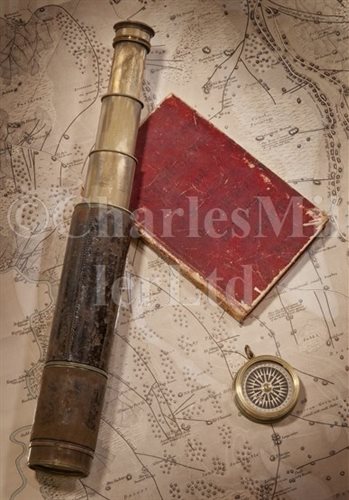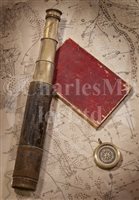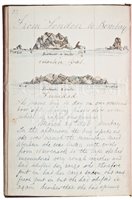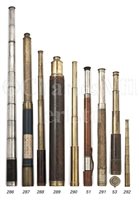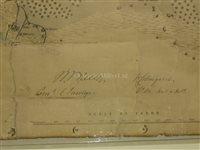30th Oct, 2013 12:00
Maritime and Scientific Models, Instruments & Art (Powerful)
53
[M] A COLLECTION OF ARTEFACTS PERTAINING TO...
comprising a passage journal kept aboard the Oriental from London to Bombay between 6th January and 30th May 1846, written over sixty-nine pages in a neat and clear hand with occasional coloured ink sketches, varied content including weather observations, poetry, and day-to-day commentary - March 31st 1846 Tuesday: A large shoal of porpoises playing about the bows the mate went out on the dolphin striker to harpoon one but was unsuccessful.. bound in red morocco with inscribed cover -- 7¼ x 4¾in. (18.5 x 12cm.); together with a presentation leather-cased 1½in. three-draw leather-covered surveying telescope and compass compendium signed and inscribed A. Ross, London / From Comr. Selby, Surveyor in Mesopotamia to Lieut. W. Collingwood, Asst. Surveyor, in kind remembrance of Services together in Babylonia & Irak Arabia, contained in leather carry case with lid enclosing a lacquered-brass compass, closed length -- 11½in. (29cm.); three 7 x 9in. (18 x 23cm.) watercolour and ink ship profiles by Collingwood of the Tigris; Coromandel and Georgiana each inscribed, signed and dated between 1856-8 and attached to ?album leaves; a printed service record for Collingwood ('H.M., late I.N.); and a map printed by J & C Walker, London of a Trigonmetrical Survey of a part of Mesopotamia by Selby and Collingwood
(7)
Commander W.B. Selby, late Royal Indian Navy, began his distinguished surveying career in 1837 when, as a midshipman, he embarked on the expedition first to lay navigation buoys in the mouths of the Indus River and thence to chart some coastal areas in the 'Horn of Africa'. By 1846 he was back working off the mouths of the Indus, having made his reputation in Mesopotamia (in 1840-41), and thereafter achieved considerable acclaim for his numerous other surveys, including those during the military expedition to Persia in 1856, before returning home (to England) at the end of 1862.
He was succeeded as Surveyor of Mesopotamia by his protégé, Lieutenant William Collingwood (a distant cousin of the Admiral), who had already done much valuable work in the region, including the large-scale, though surreptitious, mapping of Baghdad in 1855 and described by him as follows:-
"The survey of the city of Baghdad was completed entirely by myself and under very unpleasant restrictions....... The Turkish Government were not to know anything about it....... and I was left to survey the town as best I could, and under such difficulties that at times I had to note bearings and paces all over my white shirt, where best I could get the pencil at the time....."
During this same expedition, Collingwood also surveyed the Shatt-ul-Arab, the city of Bussorah (also by stealth) and much of the country between the Tigris and Euphrates Rivers, and was undoubtedly one of the most gifted and productive R.I.N. surveyors of his day.
Sold for £1,488
Estimated at £800 - £1,200
(inc. buyer's premium of 24%)
Condition Report
Journal: spine and edged rubbed; binding good and pages in good, clear conditon; telescope: optically working, leather covering rubbed, compass good overall, one leather case strap missing; watercolours: mixed condition - paper mounts with ragged edges and missing upper left corners with two of three watercolours also missing a section top left, some time staining, dirt and foxing, these will need to be removed from mounts and conserved at some point; the map is in poor overall condition with tears, foxing, staining etc..
We are pleased to provide you with a general report of the condition of this property. Since we are not professional conservators or restorers, we urge you to consult with a restorer or conservator of your choice who will be better able to provide a detailed, professional report. Prospective buyers should inspect each lot to satisfy themselves as to condition and must understand that any statement made by Charles Miller Ltd is merely a subjective, qualified opinion. Prospective buyers should also refer to any Important Notices regarding this sale, which are printed in the Sale Catalogue. NOTWITHSTANDING THIS REPORT OR ANY DISCUSSIONS CONCERNING A LOT, ALL LOTS ARE OFFERED AND SOLD “AS IS” IN ACCORDANCE WITH THE CONDITIONS OF BUSINESS PRINTED IN THE SALE CATALOGUE.
comprising a passage journal kept aboard the Oriental from London to Bombay between 6th January and 30th May 1846, written over sixty-nine pages in a neat and clear hand with occasional coloured ink sketches, varied content including weather observations, poetry, and day-to-day commentary - March 31st 1846 Tuesday: A large shoal of porpoises playing about the bows the mate went out on the dolphin striker to harpoon one but was unsuccessful.. bound in red morocco with inscribed cover -- 7¼ x 4¾in. (18.5 x 12cm.); together with a presentation leather-cased 1½in. three-draw leather-covered surveying telescope and compass compendium signed and inscribed A. Ross, London / From Comr. Selby, Surveyor in Mesopotamia to Lieut. W. Collingwood, Asst. Surveyor, in kind remembrance of Services together in Babylonia & Irak Arabia, contained in leather carry case with lid enclosing a lacquered-brass compass, closed length -- 11½in. (29cm.); three 7 x 9in. (18 x 23cm.) watercolour and ink ship profiles by Collingwood of the Tigris; Coromandel and Georgiana each inscribed, signed and dated between 1856-8 and attached to ?album leaves; a printed service record for Collingwood ('H.M., late I.N.); and a map printed by J & C Walker, London of a Trigonmetrical Survey of a part of Mesopotamia by Selby and Collingwood
(7)
Commander W.B. Selby, late Royal Indian Navy, began his distinguished surveying career in 1837 when, as a midshipman, he embarked on the expedition first to lay navigation buoys in the mouths of the Indus River and thence to chart some coastal areas in the 'Horn of Africa'. By 1846 he was back working off the mouths of the Indus, having made his reputation in Mesopotamia (in 1840-41), and thereafter achieved considerable acclaim for his numerous other surveys, including those during the military expedition to Persia in 1856, before returning home (to England) at the end of 1862.
He was succeeded as Surveyor of Mesopotamia by his protégé, Lieutenant William Collingwood (a distant cousin of the Admiral), who had already done much valuable work in the region, including the large-scale, though surreptitious, mapping of Baghdad in 1855 and described by him as follows:-
"The survey of the city of Baghdad was completed entirely by myself and under very unpleasant restrictions....... The Turkish Government were not to know anything about it....... and I was left to survey the town as best I could, and under such difficulties that at times I had to note bearings and paces all over my white shirt, where best I could get the pencil at the time....."
During this same expedition, Collingwood also surveyed the Shatt-ul-Arab, the city of Bussorah (also by stealth) and much of the country between the Tigris and Euphrates Rivers, and was undoubtedly one of the most gifted and productive R.I.N. surveyors of his day.
Auction: Maritime and Scientific Models, Instruments & Art (Powerful), 30th Oct, 2013
